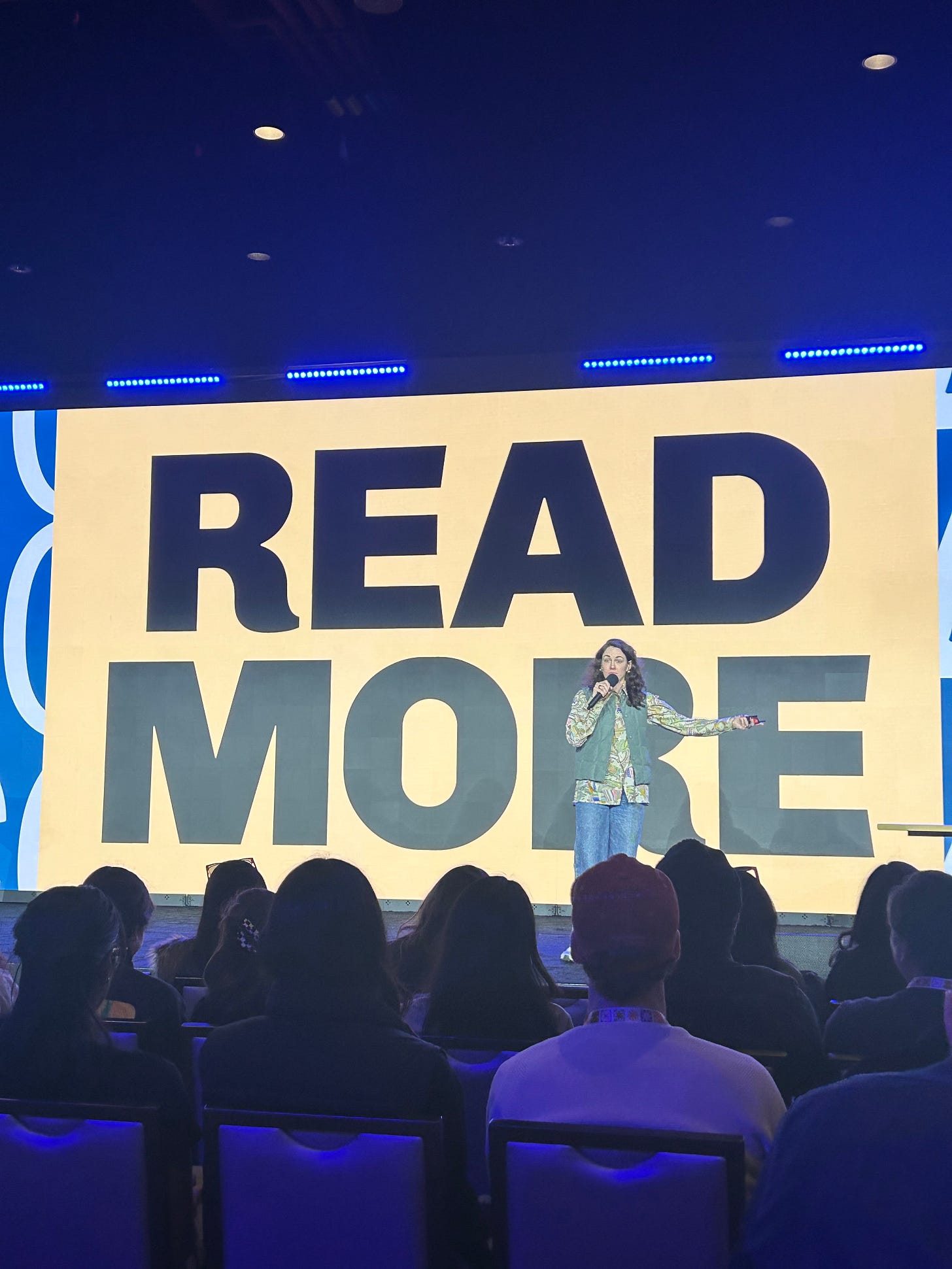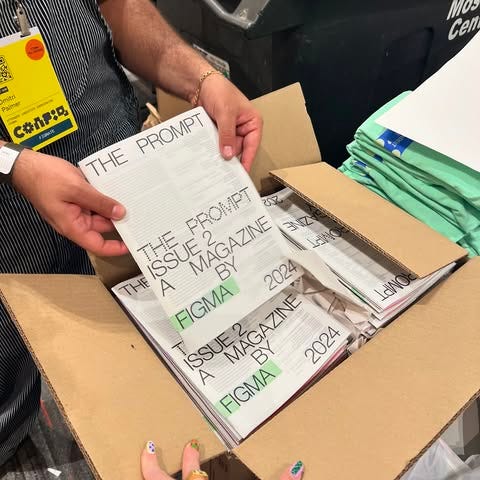IQ, UA: Some Things Just Can’t Be Copied
For Carly Ayres, the ability to discern makes all the difference.
I'm Chris, head of creative and story here at Artemis Ward. Every month I bring IQ, UA to The So What, where I chat with somebody who has a finger on the pulse of a moment unfolding in front of us — and together, in five questions + five answers (well, six this time), we try to understand what that moment really means.
Last month, former Harvard Business School dean Nitin Nohria claimed that “taste” — “judgment with style,” as he defines it — is one of the fundamental areas where we mortals can outpace the AI wave nipping at our heels. Taste, he writes in The Atlantic, “is the human fingerprint on decision making.” No matter how much content our newfangled technologies help us to ideate and generate, they don’t have the ability to discern or to curate based on a life lived and a POV hard-earned. This is the stuff of humans.
But is taste where the conversation stops? Or where it starts? Is the term “taste” — suddenly ubiquitous in conversations about people + AI — already starting to lose its meaning, as buzzwords often do? And as we continue to integrate new technologies, new platforms, and new expectations into the way we work, how do we steer brands and businesses to move at the pace of the modern world without losing that essential human touch that’s always been a differentiator?
These are no small questions to wrestle with. So it’s the perfect time to call in writer, creative director, entrepreneur, tech enthusiast, and cultural philosopher Carly Ayres. From content and UX roles at Google, Figma, and CreativeMornings to co-founding the design + tech studio HAWRAF to, most recently, helping to lead the charge at AIR — an NYC-based accelerator investing in teams that are building design-led consumer AI products — she’s spent the past decade-plus positioning herself at the busy intersection of business, technology, creativity, and culture. When she’s not sharing her perspectives with people like me, she’s dropping her thoughts on her popular Substack, Good Graf. If you don’t already subscribe, now’s the time.
Needless to say, creatives, creators, and other people in our industry right now are trying to find fresh footing in a world where AI and technology and all sorts of advancements around us are playing bigger roles in how we do our work day to day. One of the things that people point to as being distinctly human, though, is “taste.” I'm curious: How would you define taste? And why should we see it as a fundamentally human thing?
Gosh! Taste is hard. At this point, I'm wondering: What is the thing beyond taste? I feel like we can't even say taste anymore — it’s starting to feel very, very overplayed. That said, I think, when we talk about taste, what we're talking about is: What is a point of view? It comes from what you're exposed to. What you notice. What you choose to remember. Taste is the ability to pause, discern, to decide what matters.
Now that I'm working with early-stage startups, I hear people ask things like: How can you teach a machine taste? How can you have apps that are like curations of your taste? I think machines are very good at pattern recognition, but they won't have your unique point of view, which is something that only comes from going out in the world, living, experiencing things, and then kind of developing what that point of view is.
Yes, the inputs are reflections of the experiences that we have as humans. And you really can't replicate that. So, what other aspects of the ideation and creation that we engage in do you think are fundamentally human? Where else are humans still firmly in the lead?
Take copywriting. I think the discernment of editing is something that you can't automate — like being able to just read something, speak it out loud, and decide, okay, here's what I need to cut. Here's what I need to add. You can generate thousands and thousands of words, endless words, and you can make endless images, and you can make yourself look like a Studio Ghibli character. But what machines can't do is anything new that hasn't been done before — that is an innately human thing.
The newness goes back to the inputs you were talking about earlier — that's the trick. However it gets created, there’s a lot of content in front of us right now. You recently wrote about this tension between content that's built to resonate and content that is built to endure. I'm wondering what you think about the difference between the two.
I've been thinking about this a lot lately with my own writing. [On my Substack] I've been doing these kinds of newsy recaps of what's happening. And they’re helpful for digesting what's happening right now, but I'm never going to want to look back on them. So, I’ve been thinking about what it would mean to write something that is a little more evergreen — that speaks to this moment in time, and where things are, but also where things are going. The stuff that endures is the stuff that informs something greater than perhaps just this moment.
Do you ever watch TikToks? If you've ever watched TikToks and all of a sudden you realize a lot of time has escaped you, and you can't name a single video you just watched — that's stuff that's maybe not meant to endure.
What you’re saying makes a ton of sense, particularly for an individual who's creating content. But for brands and for businesses and for companies, how important is it to think about creating content that can endure? Or is it more important to create the pulses that resonate — that move at the speed of the world around us, and then get attention?
That's a great question, Chris. And, like most answers, it depends. I actually think the best work probably does a bit of both. One rewards speed and relevance and will probably spread a lot further more quickly. The other is a little bit more about depth and rigor, and so it’s going to last a lot longer. I think it’s about knowing which levers you're pulling. You can only engineer that so much, but to try to do it somewhat deliberately is probably the key there. Like most things, applying a lens of intention to what you're trying to achieve is the thing.
That leads to my next question. You often talk about the power of storytelling. As a writer myself, I spend a lot of time thinking about narrative and the components of storytelling — which is much more than just chronology or basic cause-and-effect. As we think about content that endures, I think genuine stories have the power to endure where sometimes content can just be blips. So, for you, in today's world, with new technologies, new platforms, new attention spans, how do you think storytelling is different now than you might have said it was five years ago? And what are the aspects of it, too, that are the same as it's always been?
Everything's the same as it's ever been. I mean, I think a lot of the principles of storytelling are always true. But what's changed the most is the container, you know? Tell a story in a tweet. When you’ve only got so many characters, how can you make every single one matter? And how do you stay true to those principles when you scale that out to a blog post, or when it’s a Reel, or it's a launch video, or it's an interactive parallax scroll website, or even an app onboarding?
We also have a lot more knowledge and data points than we used to have. Now we know who is receiving that story, where they are, what their surrounding context is — if they’re going to be reading it on a blog, or maybe they'll get it on an e-reader device or on their phone. So, I think you have a lot more information that [you can use to] make a story that much more impactful.
With so many moving parts, brands are trying to find the best ways to make stories that won’t get lost in the busy and chaotic landscape we’re in right now. The old sort of set-it-and-forget-it model for brands doesn't really pertain anymore. That doesn't mean that there shouldn't be a solid core to the brand. But brands need to be able to evolve. They can really fail themselves when they become too static. What advice would you give to brands in terms of what it means to stand out in the years to come?
Isn't that the one-million-dollar question? We're all trying to figure that out. I think it all really comes down to intentionality. About what feels deliberate and thoughtful and considered. What feels unique to you. And ideally, that will be something that no one can copy.
Note that this interview has been edited for length and clarity.
🎨 Keep up with Carly on LinkedIn and Instagram — and check out her Substack to read more about substance and style in the world of design and tech.
✉️ And, if you haven’t yet subscribed, click the button below so you don’t miss the next one, where decodes aura farming for brands.










